The 16 megapixel Olympus Stylus TG-4 Tough waterproof camera is one of the best waterproof camera options available in 2016. Is it perfect? No. But it’s darn good. In this review I’ll cover the standout features, where it fits best, and help you learn if the TG-4 is right for you.
This summer the pros over at B&H Photo Video hooked me up with seven — that’s right, seven — waterproof digital cameras, which I promptly took fly fishing and out playing on the river . . . all at the same time. The Olympus TG-4 was one of these waterproof wonders. The experience of using it, right next to other great cameras, revealed what I like about it most — and where I wish it could improve.
To be clear, the only reason to buy a TG-4 is if you want a tough, rugged, waterproof camera that you can swim with, take boating, use in the rain, snow, and drop in the mud or sand. If this sounds like you, read on!
Hands-On: The Olympus TG-4 Review
The Olympus TG-4 Tough is waterproof down to 50 feet, shockproof to 7 feet, freezeproof to 14F, and crushproof to 220lbs, but the best feature of the TG-4 is its fast f2.0 lens. It’s a 25-100mm equivalent f2.0-4.9 lens, which can basically let in more light than most other rugged waterproof cameras. In low light situations, this should help it take better photos, plus let you snap pictures a bit faster than other cameras with, say, f3.0 or higher lenses.
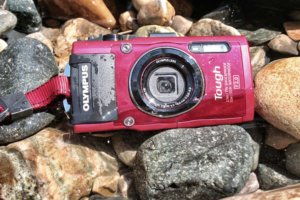
In practice, pointing and shooting the TG-4 was a bit faster than using the (also excellent) Nikon AW130. And what do I mean by faster? I mean that I could hold the camera up, half-press the shutter button to focus, and snap a photo. All that action going on with the TG-4 was slightly faster than the other cameras I put to work, in a variety of lighting conditions — but only slightly. To be fair, I was also pleased with the speed of the AW130 and TS6.
So what about photo quality? For me, there are so many scene options and fine-tuning available in all of today’s adventure cameras that it’s not worth trying to eek out a small difference in quality. This class of camera tends to use similar sensor sizes, and even the “pro” photography sites tend to rate the photo qualities of these cameras as pretty close together. The bottom line? The TG-4 is at the top of this class of lightweight, rugged and pocketable cameras.
Before we get off the photo quality angle, though, you should know that the TG-4 is the only camera in this class that will let you shoot RAW photos (which lets pros fine-tune images themselves rather than letting the built-in camera processor do it when it creates a .jpg file when you take a photo). This might mean that one day you could transform a fantastic photo in a spectacular photo — but most people will be better served by holding the camera steady and framing the shot and letting the camera process the image into a .jpg.
Rugged Feel, Menus, and Buttons
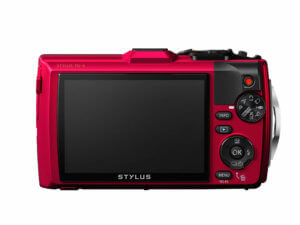
The TG-4 is a burly little camera — small enough to pocket yet built well enough to trust. I never worried about hurting it, other than outright dropping it onto sharp rocks. It has build quality that puts it in the top 3 of this class.
As for the Olympus menu system, it’s easy enough to learn. No worries there.
And buttons? All good, no major issues. Most importantly, it has an easy to see, easy to use red button you can use to instantly start recording video. When you hand your camera to a friend to get a video of bigfoot or a flying saucer, you want the video recording button easy to find and use. Or when you bust a wicked move behind a ski boat.
How about the rear screen? It’s great in the shade or indoors, but it washes out in bright sunlight (which they all do, unfortunately).
TG-4 Add-on Lenses & Accessories
Another feature that sets the TG-4 apart is the ability to use optional add-on lenses — a telephoto lens extends the standard 4x optical zoom to 7x while a fish-eye lens creates a wide field of view. These lenses provide some really interesting new opportunities for zooming in or seeing more when you’re using your TG-4 like an action camera.
If you get addicted to macro photography — say, close up photos of flowers or cool bugs — you can get an LED Light Guide that will evenly illuminate small things when you’re up close and personal and using the cool Microscope mode. If you wanted to, you could create some awesome close-up photos with the TG-4.
All of these accessories make the TG-4 super versatile. (The downside is the extra cost, but no one says you have to buy the add-on lenses right away.)
WiFi, GPS, and Shooting Modes
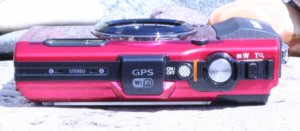
Most great rugged waterproof cameras include built-in WiFi connectivity that works with smartphone apps, as well as built-in GPS that can tag photos and include location information — and the TG-4 is no exception here. The GPS is reasonably fast, and the e.Compass can track altitude and even water depth.
Like the best point-and-shoot waterproof cameras, the TG-4 includes all the core shooting modes to help you nearly automatically tune your camera to your shooting environment. The Underwater mode, for example, will help deliver richer color while you can use scene modes for special events like sunsets or fireworks displays. There’s even one for “cuisine” if you’re into snapping photos of your food. Plus, the TG-4 includes art filters for dramatic tones, grainy photos, and lots more.
Basically, the TG-4 has all the shooting modes and features most people will ever need.
Weakness? TG-4 Video
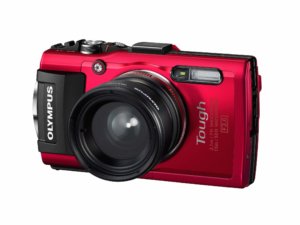
In my mind, the only downside to the TG-4 is that its Full HD 1080p video mode maxes out at 30 frames per second. Where does this matter? Shooting action video that you want to be liquid smooth. For me, I want to be recording important action at 60fps, which, while not perfect for everything, is the balance I want. For some, though, this isn’t exactly an issue. For instance, you don’t need 60fps to shoot a great video of your kid digging sand at the beach. But when the action gets faster, with more movement, I want 60fps in the relatively large 1080p size.
Meanwhile, this is a bit nitpicking because the 1080p at 30fps is OK compared to other video shot at 60fps — it’s only when you really start trying to isolate certain elements that you notice differences. For casual watching and online posting, 30fps with the TG-4 is acceptable. For instance, I placed seven different cameras in my backyard to record a section of shadow as well as bright sunlight, catching wind in the trees and changing shadows on the ground. I then turned on a water sprinkler and started recording. I then bounced some balls across the view, into the spraying water, and then I personally ran around like a drunk monkey in front of the cameras (which is why you’re never going to see these videos).
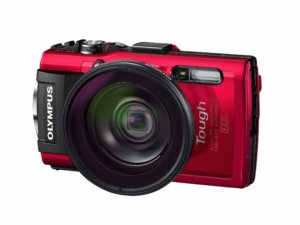
The result?
The TG-4 was pretty good. About as good as the AW130, which was also recording 1080p at 30fps, but both were not as smooth as the TS-6, which was recording at 60fps. A HERO4 Silver, by the way, looked the best at 1080p at 60fps, but the ultra wide-angle lens gave the scene a whole different feel — namely, it covered more area and made it all seem farther away. Pros and cons.
There’s another wrinkle, though — image stabilization. If you’re holding the camera, which will almost always be the case, the image stabilization helps improve the video compared to other cameras that don’t have it.
So how does this video performance fit into your life? Here’s an example: If you had two choices, a GoPro (best for action video) and a TG-4 (best for photos), and you had the chance to film a frolicking baby mountain goat, which would I pick? The TG-4, hands down. Why? The GoPro has a fixed lens with no zoom. While I might get a smoother overall video at 60fps with the GoPro, the goat will seem far away in the video. With the TG-4, I could zoom in on the baby goat and get the better video footage of a lifetime. And if I spotted some mountain goats clinging to a sheer rock wall while backpacking, the GoPro would also be useless but I could get an awesome photo with the TG-4, especially if I had an add-on Telephoto Lens in my pocket.
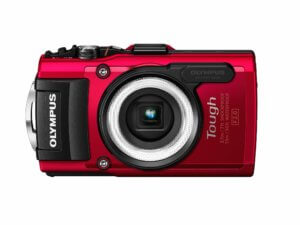
Here’s my dirt-simple recommendation:
Get the Olympus TG-4 Tough camera if you want a high-quality rugged camera and you care most about being able to snap all sorts of photos that will hit the high end of quality for this class of camera. Plus, choose the TG-4 because you appreciate the zoom and fisheye add-on lens options, as well as the macro LED Light Guide for taking photos of the amazing world inside tiny objects.
One last note: Be sure to buy a fast, high-quality SDHC card. For the best overall value and fast speed, I use the SanDisk Extreme Pro — totally worth a few bucks extra over slower cards (slower cards can sometimes limit camera performance).
Get the Gear:
Note: B&H Photo Video typically offers fast and free 2-day shipping for most everything over $50.
- Olympus TG-4 . . . from B&H Photo Video . . . or from Amazon
- Olympus TG-4 Telephoto Lens . . . from B&H . . . or from Amazon
- Olympus TG-4 Fisheye Lens . . . from B&H . . . or from Amazon
- Olympus TG-4 LED Light Guide . . . from B&H . . . or from Amazon
- Olympus TG-4 Sport Case . . . from B&H . . . or from Amazon
- SanDisk Extreme Pro SDHC . . . from B&H . . . or from Amazon


